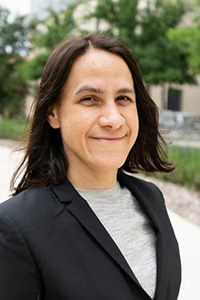Date/Time
Date(s) - 09/13/2022
9:15 am - 10:15 am
Location
New Engineering Building - Room 100
Categories
Delia J. Milliron, Ph.D.
T. Brockett Hudson Professor and Department Chair of Chemical Engineering
University of Texas at Austin
Title: Switchable optical materials from metal oxide nanocrystals
Abstract: Dynamic control over light has myriad applications from telecommunications to chemical sensing and therapeutics. Modulating interaction of materials with infrared light is useful for energy applications, like smart windows and active cooling, applications that require materials at scale. I will discuss two distinct strategies for modulating visible and infrared light with materials crafted from colloidal metal oxide nanocrystals. One approach involves reversible structural reorganization of gel networks, where plasmonic coupling in the assemblies strongly modifies the infrared absorption. Here, the building blocks are tin-doped indium oxide (ITO) nanocrystals with synthetically tunable plasmonic absorption spectra. A second approach involves reversible electrochemical charging of transition metal oxide nanocrystals (tungsten and niobium oxides). Charging results in strong absorption of either visible or infrared light depending on the electronic state resulting from ion intercalation. Overall, metal oxide nanocrystals offer compelling opportunities as building blocks for dynamic and tunable optical and electronic materials.
Bio:
Delia J. Milliron is the T. Brockett Hudson Professor and Department Chair of Chemical Engineering at the University of Texas at Austin. Dr. Milliron received her AB from Princeton University in 1999 and her PhD from the University of California, Berkeley in 2004, both in Chemistry. From 2004 to 2008 she worked for IBM’s research division, initially as a postdoctoral researcher and then as a member of the research staff. In 2008, she joined the research staff at the Molecular Foundry, Lawrence Berkeley National Lab, where she served as the Director of the Inorganic Nanostructures Facility and later as the Deputy Director. Dr. Milliron’s research involves nanocrystal-based materials in which abundant interfacial area and confined volume produce drastically different properties than those of homogeneous bulk materials. Such properties represent a growing opportunity to design materials to meet simultaneous, sometimes disparate performance requirements for applications including electronics and clean energy.

